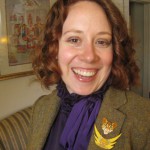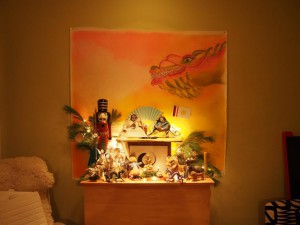Friday
Featured StoriesThe Magic of Children’s Day
COLUMN: Living Shambhala CultureHow a Children’s Day Shrine can Teach us About the Three Courts
by Amanda Hester, Adjutant to the Shambhala Office of Culture and Decorum
Batman is awesome. He makes me feel like the impossible is possible . . . I’m Batman!
Drala can be translated as being beyond duality. It is the experience of non-dual reality, which is always possible. It is potential in every experience. Certain configurations are more or less conducive to our having this experience or realization, but if we open our mind and heart to it we can experience the drala, the non-dual reality, of absolutely anything and everything. Indeed, that is the point! The practice of Culture and Decorum is about taking the important training and practice that we do in the shrineroom, on the cushion, and actively applying that to our lives off the cushion, in our households, communities, and society at large. We have view, and forms, and various skilful means to help guide us in doing this, and to help keep us on task. But that is where we land, where the rubber hits the road.
As adults, we can fall into absurd territorialities, like I just did: what happens in the shrineroom, on the cushion, vs. what happens out. We become fixated on these attachments we’ve created, our attachment to our point of view, to our conceptualizations and configurations, and ultimately, they aren’t really furthering us at all. They are just silly. A child’s mind finds such things ridiculous.
The contemplation of a Children’s Day Shrine has liberated me. It shatters my absurdities. It is a shrine, and more often than not it is found in the living room! It is the purview of all and of none. It completely transcends attachment. It completely manifests sacred vision and sacred world. It opens up a window into direct perception, for I ask you, how can you possibly contain, or create boundaries around what a Children’s Day shrine is, or isn’t, or even where it resides?
A Children’s Day shrine, for those who don’t know, is the Shambhala equivalent of a Christmas tree. Although, the two are by no means mutually exclusive! It is a shrine that is not bound by convention. It can take any manner of manifestation, and no two, in all the history of nowness, have ever been exactly alike. It is a fluid, untrammelled, and wild thing. Often the shrine has toys on it that get played with, that roam around the room, or the house, or to other friend’s houses, or to centers, or schools, or doctor’s offices, before returning to their lofty perch. It usually has some representation of the four dignities.
Growing up in a Shambhala household, our children’s day shrine has always met this dignity element with beautiful glass figures of a family of pigs, dogs, and deer, some blown glass figures of monkeys and dragons, and a precious plastic baby Jesus nativity scene with porcelain angels, which I am particularly fond of. Where the meek and outrageous lie in all of this shifts and changes from moment to moment, and the more these figures get played with, and chipped, and broken, and glued back together, the more sacredness they acquire.

photo by Benny Fong; photo can be used for your own Children’s Day shrine, or the Children’s Day Shrine at your Shambhala Center
That is what Children’s Day is about. It is about creating magic. That is what the practice of Culture and Decorum is about too, creating environments where auspiciousness can occur. Magic! Children’s Day teaches us what magic is. It is where our Culture and Decorum reps have to go for their training. I will say to them, magic has to train you, I can’t! The magic of a Kungfu Panda weekend matinee, and its sea of shimmering laughter.
Drala is powerful. It is there in the magic of an NFL play-off game, in a ballet, a skateboard, a concert, the symphony, maybe a particularly good rendition of the Nutcracker. The power of a group of people connecting to their heart, getting stoked, feeling the awesome power of basic goodness, it is an interesting energy to have to cultivate and work with. It can turn on you, and it can be dangerous. It can also change the world. How we shape and hold and spark that energy, is what the Shambhala forms are all about. But we have to understand them the way that our children do.
The magic of Children’s Day is in the sound of voices singing together, in the squeal of toddlers, and the cry of infants, and that weird laughter that adults make sometimes, and the gasp of the kids when they meet the King and Queen, whom they almost feel like they recognize! The magic of Children’s Day is in the palpable sense of people loving each other. It is the hope of daylight returning. It is the magic of twinkly lights in winter. Because drala is there when your heart breaks, and when your heart soars, and that is the magic of sacred world.
 ~~
~~
Amanda Hester lives in Halifax Nova Scotia, where she has been the adjutant director for the Shambhala Office of Culture and Decorum for the last two years. She is in the process of writing a series of fantasy fiction novels about basic goodness, and a non-fiction book about enlightened military. Visit her new website at: amandahester.com


















Dec 23, 2013
Reply
Queen Wonder Woman–I love that! But Batman? Please explain!